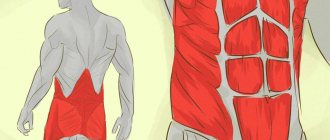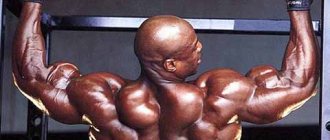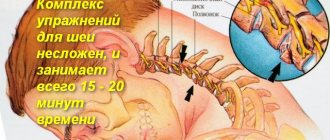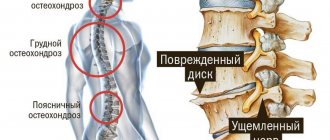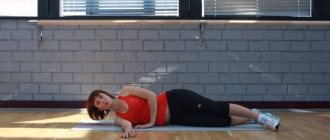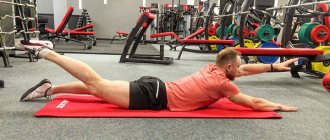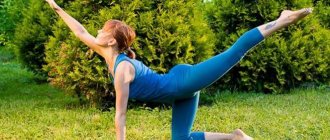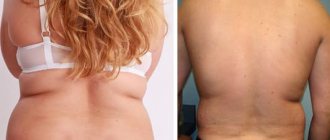Syndromes of lumbago disease 124
Tension in the lower back is a rather unpleasant sensation that prevents you from performing your usual movements. A person cannot freely bend over, straighten up on his own, or even turn over in bed, and this is difficult. Meanwhile, this is a very serious sign of the development of diseases of the spinal column. And you need to see a specialist as soon as possible. They will conduct an examination, make an accurate diagnosis and develop effective treatment.
In this article you can learn about the reasons for pain and tension in the lower back and which doctors you should contact in a particular case. The main pathologies of the spinal column and surrounding tissues are considered. It tells about the distinctive differential features that need to be paid close attention to.
To begin with, it is worth understanding that back tension in the lower back can be triggered by a wide variety of etiological factors. Most often this is:
- excessive tension of the muscle fiber for compensatory purposes;
- formation of internal hematoma after traumatic impact on soft tissues;
- violation of the integrity of bone, ligament, muscle and tendon tissue;
- interruption of the path of nerve impulses along motor-type axons;
- swelling of the soft tissues, putting strong pressure on the surrounding muscles.
To understand the mechanism of the sensation of tension, you need to know the basics of anatomy and physiology. For example, the spinal column is a prefabricated structure, which contains vertebral bodies interconnected by longitudinal and transverse ligaments and intervertebral joints. This design is quite flexible. When the function of a ligament or joint is impaired, a so-called tension is observed. It does not allow further movements, as a result of which the patient’s condition may worsen.
The second point is that the structure of the spine contains intervertebral cartilaginous discs. Their anatomical feature is the complete absence of their own circulatory network. They can receive a sufficient amount of fluid and nutrients for recovery only during diffuse exchange with the surrounding muscle tissue.
If diffuse metabolism is disrupted due to a person’s unhealthy lifestyle, then the fibrous ring of the intervertebral disc becomes dehydrated. It loses its elasticity and ability to absorb liquid in the future. As a result, osteochondrosis and protrusion (subsidence of the spinal discs) develop.
With a sharp decrease in the height of the intervertebral disc, the protective compensatory mechanism of muscle fiber overstrain is activated. At this moment, a person feels strong tension in the back and lower back.
And finally, this is a fact - the human spinal column has 4 physiological curves. This is necessary for a more uniform and safe unloading when distributing the shock-absorbing force while driving. Most modern people experience pronation of physiological curves or strengthening. For example, a round or stooped back and compensatory smoothing of the lumbar curve. And this leads to the fact that the muscles located in the paravertebral region are forced to take on a large mechanical load. This certainly provokes a feeling of tension.
And these are not all possible pathological changes. There are also more serious diseases. For example, with the appearance of such a symptom, the body can signal damage to the dural membranes of the spinal cord, stenosis of the spinal canal, prolapse or sequestration of intervertebral hernia, etc.
We strongly recommend that if you feel tension in the lumbar region, you should immediately consult a doctor. It is advisable to immediately make an appointment with a vertebrologist. This doctor specializes in the treatment of the spinal column and has the necessary professional competence to do so. You can also visit a neurologist or orthopedist. The local therapist is unlikely to be able to help you cope with the developing disease. At best, he will prescribe symptomatic treatment that will eliminate the feeling of tension, but in this case the process of destruction will only intensify.
Why does muscle spasm occur and how to deal with it?
So, a person made a sudden movement, pulled a muscle, sat in a draft, was in a static position for a long time in an uncomfortable position, and a muscle spasm occurred.
Muscle spasms often occur after exposure to a draft
The mechanics are as follows: at the moment of spasm, all intramuscular fibers simultaneously contract, forming a kind of protective shaft, trying to protect the tissue from further irritation. Pain occurs and intensifies, creating even greater muscle tension.
Most often in the human body, the spinal (lumbar) and cervical muscles spasm. For some people, one or more of these muscles (and sometimes both) are constantly tense. These areas are the most sensitive to stress. And a person most often “exposes” them to attack.
Superficial back muscles
Deep back muscles
By the way. Spasmodic back pain, if accompanied by severe numbness of the skin tissue, tingling, muscular dystrophy, may indicate such serious pathologies as a ruptured intervertebral disc or nerve.
Intervertebral disc rupture
The main cause of back pain, therefore, can be considered the initial excessive contraction and subsequent spasm of the deep muscles, leading to blocked nerve endings and deformation of the discs.
What to do?
How to relax your muscles and avoid spasms? There are many ways to relax, the most effective of which is stretching in progressive alternation with active maximum tension.
You can relax your muscles by doing simple exercises
Important! When a muscle works, its chemical energy is produced to the maximum in the anaerobic stage, in the absence of oxygen. The aerobic part of the activity, saturated with oxygen, allows muscle fibers to power the muscles, increasing their endurance in the long term. Thus, stretching supplies the muscle with chemical energy, ensuring its transition to nervous energy.
A traumatic or stressful situation that causes a muscle to tense programs the brain, perpetuating the resulting spasm. Even after the situation that caused the spasm has ceased, the body remembers the pattern of motor restriction and follows it. Static and dynamic exercises can normalize muscle function and break the vicious circle.
Table. Ways to relax a spasmed muscle.
| Way | Description |
| Physical exercises for consistent tension and relaxation of muscles must be done in such a way that the whole body works - from the feet to the facial muscles. |
| During the exercises, full breathing is used with inhalation in an episode of tension and exhalation in an episode of relaxation. This increases the effect several times. |
| The spasmed muscle must be tensed as much as possible and this state must be maintained for thirty seconds. |
| It is necessary to use all massage movements - vibration, kneading, deep pressure. You can alternate massage movements with extreme tension. |
| Using light massage movements, rub the muscle with an ice cube for several minutes. Ice constricts the blood vessels, followed by a sharp expansion, the muscle relaxes, and restored blood circulation works to restore the muscle’s ability to contract and relax in a normal rhythm. |
These methods allow you to provide first aid to a tense muscle and relieve spasm. If spastic phenomena occur again, more radical methods will be needed.
Advice. To try to relax a tightly spasmed muscle, you must first relieve the sensation of acute pain and swelling. This can be done with topical medications or oral medications.
Relaxation with warmth
When the swelling subsides and the sharp pain can be relieved with medication, the muscle will still remain tense, and the pain will return again if it is not relaxed. At this stage, it is good to use relaxation using heat. It will provide a rush of blood to the problem area.
An example of the impact on the back muscles with a hot bag of salt and herbs
It is best to warm up the muscle with a warm or warming compress. You can warm a towel or use heated salt, sand, other heat-retaining material, or warming ointments. A compress is applied to the problem area, covered with a film and additional heat-storing material (wool, fur).
Warm compress on the back
Advice. The warming procedure should not be long, twenty minutes is enough, but it must be repeated up to five times a day until the spasm completely disappears.
Stretching
To maintain the muscle's ability to relax again, it needs to be stretched periodically. This is especially true for older people, since in the body of an elderly person tendons contract and muscle flexibility decreases. Daily stretching exercises, performed with proper pulmonary breathing, will help maintain flexibility, posture and normal muscle condition.
Back stretching exercises
Massage
This category includes not only manual massage performed by a professional massage therapist (not every person can afford this, although if the muscles are constantly tense, a course of manual massage is very useful), but also hardware and self-massage. Swimming is also very good for muscle tone, especially on the back or breaststroke.
Hardware massage is very effective and widespread. You can choose a suitable electric massager for home use. The main thing is to choose the right model, taking into account the power, quality and quantity of attachments, and the presence of additional functions. Read about all the intricacies of choosing an electric massager for your back and neck in the article at the link.
Sauna
If a sauna is not contraindicated for health reasons, it can bring a tremendous effect, combining massage (using a broom or self-massage techniques), warmth and relaxation. In addition, toxic substances are actively removed from the body, which normalizes the nutrition of muscles, cartilage and bone structures.
The change between the heat of the bath and the coolness of the dressing room stimulates the most hidden forces of the body
Due to the restoration of blood flow and normalization of nutrition, inflammation of compressed nerve roots is relieved, joint mobility is restored, the production of interarticular fluid is normalized, and pain goes away.
The sauna is recommended for relaxation at any age, unless there are contraindications associated with certain diseases.
Sauna is useful at any age
All of the above methods usually begin to be used when muscle spasm reaches a critical point. When, due to the inability to relax the back muscles in a timely manner, the spine bends, the vertebrae shift, pain occurs, vision or hearing deteriorates, and headaches occur due to impaired blood flow. When muscle fibers are contaminated, the skin dries out and becomes sluggish, and not only does the cells not receive adequate nutrition, but also they are not cleansed.
But if you pay attention to the problem earlier, at the first symptoms of muscle tightness, and regularly, and not occasionally, prevent muscle spasms, restoring the muscles’ ability to relax, you can maintain muscle tone for a long time, thereby maintaining and improving health.
Gymnastics copes best with this task.
Massage
Regular therapeutic massage helps to relax and relax the back. It is best if it is performed by a specialist, but you can perform the massage yourself at home. For this purpose, special devices such as massagers are sold. In some cases, you can ask a loved one to massage the problem area. But it is worth remembering that a massage should be relaxing.
Relaxing gymnastics for back muscles
The “secret” of the effective impact of gymnastic exercises for the prevention of muscle spasms is the correctness and regularity of their implementation. You need to prepare for the process - remove all discomfort and muscle pain, relieve swelling.
Advice. Under no circumstances should you do gymnastics through pain, hoping that the muscles will warm up and it will go away. This way you can even injure a muscle and get a ligament rupture.
Exercise 1
Lying on your back with your legs together, completely relax your body. Simultaneously make smooth movements left and right with both feet. The entire lower body works, but the buttocks and legs do not leave the floor.
Exercise 1
Exercise 2
With your body motionless and tightly adjacent to the floor, turn your head smoothly, as if swaying from side to side.
Exercise 2
Exercise 3
Rocking is carried out from the previous position with the feet and head simultaneously, synchronously, in the same direction, or not synchronously, in different directions.
Exercise 3
Exercise 4
Raise your arms up, bend them and grab yourself by the elbows. Rocking is done with the arms and body. Try to perform the exercise with a wide amplitude, but without sudden turns of the body.
Exercise 4
Exercise 5
Roll over onto your stomach. Bend your arms in front of your face, place your forehead on your palms. Place your feet on your toes and rock your heels.
Exercise 5
After finishing, smoothly roll over onto your side, bend your knees and slowly stand up. Perform each swing for two minutes. Exercise positively, listening to your body, trying to let relaxation pass through you, to feel it.
Neck relaxation exercises
Gymnastics for the whole body, especially for the neck, should be done in the morning to strengthen the muscle corset, and throughout the day to relax the muscles. Exercises help to activate blood circulation, increase the flow of oxygen, and stretch stiff muscles in the neck and shoulders. Charging can be the simplest and most accessible to everyone:
- tilting the head back and forth;
- bending to the sides;
- rotation of the head in different directions;
- Resistance exercises in which the arms try to push the head to one side, such as forward, and the neck muscles resist by pushing the head back.
After doing the gymnastics, you need to relax your neck and head as much as possible, feeling the tension go away.
Breathing should be deep and even in order to maximally enrich the body with oxygen. In general, breathing exercises in a calm environment also have a good positive effect on muscle relaxation.
Physical education - clinics in
Choose among the best clinics based on reviews and the best price and make an appointment
Family
Medical
Moscow, st.
Arbat, 28/1 building 1 Smolenskaya
+7(495)212-90-98
- Reception from 700
- Neurology from 700
- Physiotherapy from 155
10 Write your review
Family
Medical
Moscow, Maroseyka, 10/1, building 3
Kitay-Gorod
+7
- Reception from 7500
- Manual therapy from 2000
- Massage from 2000
9 Write your review
Family
Medical
Moscow, Kurkinskoe highway, 30
Planernaya
+7
- Reception from 1300
- Manual therapy from 3000
- Kinesiotherapy from 1800
10 Write your review
Show all Moscow clinics
Ways to relieve tension from the muscles of the cervical spine
Severe, prolonged pain is a symptom of the need to see a doctor.
You can independently relieve muscle tension in the neck and shoulders if you apply skills and abilities correctly. Try to drink more. Water will restore elasticity to the muscles and rid the fibers of toxins. This is facilitated by nutrition - foods with vitamin B12, magnesium, zinc. Ways to relax:
- gymnastics, exercises;
- massage - independently or with outside help;
- warm, cold compresses;
- body relaxation or breathing techniques;
- medications, mineral or vitamin supplements.
Physical education - specialists in Moscow
Choose among the best specialists based on reviews and the best price and make an appointment
Massage therapist
Zakrevskaya Natalya Alekseevna
Moscow, 1st Lyusinovsky Lane, 3 B. (Medical) +7
0 Write your review
Masseur
Avtandilyan Arsen Alikovich
Moscow, Landyshevaya st., 14, bldg. 1 (Medical)
+7
0 Write your review
Masseur
